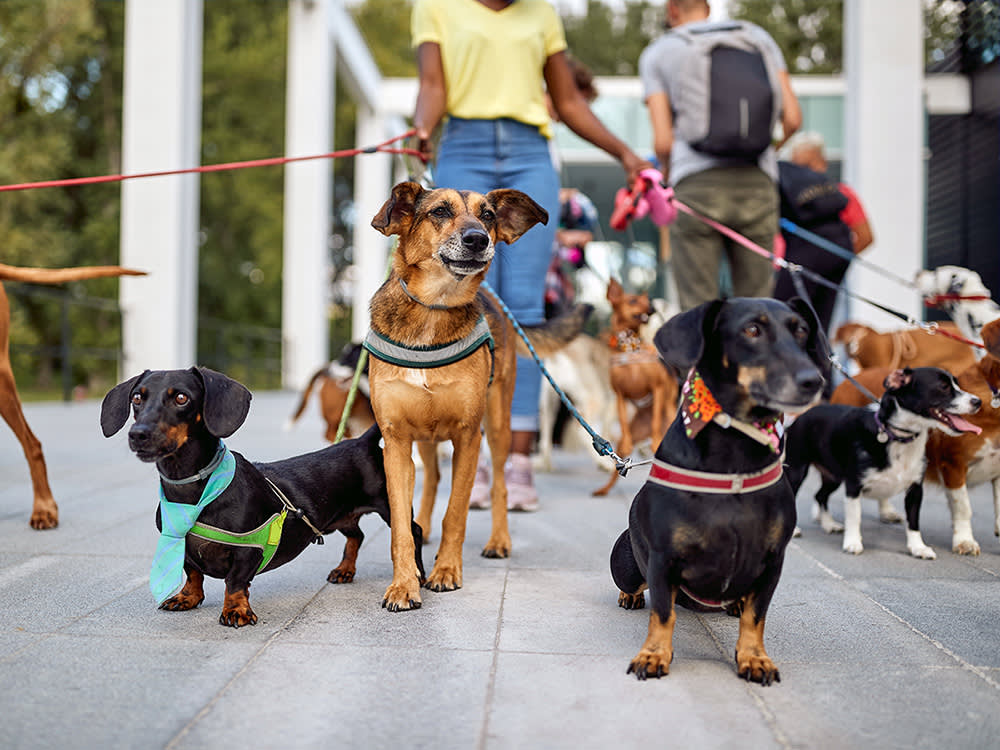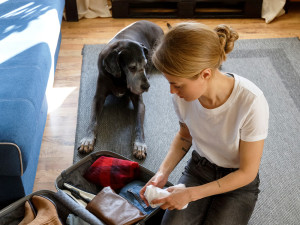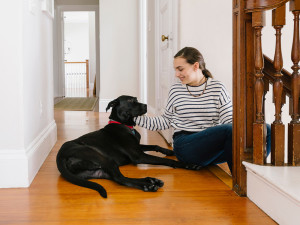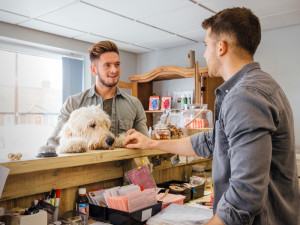How to Start a Professional Dog-Walking Service
Everything you’ll need to start your career in pet walking.

Share Article
When I envisioned my dog-walking service, I saw myself dressed in a cute white sweater and 501 red-tag Levis, walking along the Pacific shoreline with six attentive, well-behaved Golden Retrievers and Labradors. Being my own boss, making my own hours, and being around dogs all day. What could be better?
Reality hit on my second day of professional dog-walking when I twisted my ankle and fell face-first into the sand after chasing a ball-obsessed, overweight yellow Labrador named Willard and a Sheepdog named Bear who behaved like she was on an acid trip. Sand was everywhere—it was an exceptionally bad start to my new career in dog walking.
So, what did I do? I brushed myself off, took a shower, and continued building my new business, which in time evolved into a client list of 80 dogs, eight employees, and a fleet of five dog-appropriate vehicles. I love dogs, and my passion outweighed the hazards of the job. Perhaps you secretly harbor the same dream. If so, here are some tips to help you get started starting your own professional pet walking service.
Do your research.
Investigate dog-walking services in your area. When I first started, an off-leash adventure service—one that allowed time for a Labrador Retriever to swim, play chase and destroy picnics—didn’t exist. (Just joking about picnics.) Once you figure out the type of service your area needs, you can begin developing your business.
How much do you spend on your pet per year?

Create a business plan.
How many dogs can you safely take in a group? How many shifts a day? How long for each walk? How much will you charge? What areas of town will you service? Don’t spread yourself too thin. Choose an area near where you live or, better yet, as my Wall Street financial-analyst father told me, “Choose a recession-proof area; if they lose a million in the market, it won’t matter and they’ll keep you employed so you can pay the rent.”
Establish your business structure.
Most dog-walking services are set up as either a sole proprietorship or an LLC. A sole proprietorship means that the owner’s personal and business assets are in the same pot, so to speak, and they are responsible for all debts. An LLC separates the personal and business assets. Incorporation is also an option; in that structure, the owner is not personally liable for the company debts. At first, I had a sole proprietorship but changed to an LLC when I hired employees and then married a fiscally responsible guy who worried about protecting our assets and home.
Set your pricing.
Check out your competition’s rates and services. In 1995 when I started, the average San Francisco dog walking rate was $8 per walk. I charged $5 to build up a clientele but, in retrospect, realized that I had devalued my services, which included longer walks and more time out of the house than the others were providing. These days, the average per walk rate ranges from $10 to $35, depending on the area. If you have the skill set, you may also want to offer obedience training and pet-sitting for an additional fee.
Draw up a contract.
Have clients sign a contract that covers at least the basics: information about the dog, any training or behavioral problems, who to contact in an emergency, and contact info for the family vet. Also include a release from liability as well as permission to seek vet care if needed (and to be reimbursed for that care, if it comes to that).
Build a website and a social media presence.
Wordpressopens in new tab, Squarespaceopens in new tab and Shopifyopens in new tab are three highly rated website and ecommerce platforms. Constructing a social media presence through Facebook, Twitter and Instagram is also fundamental for business growth. Eventually, you’ll probably get most of your business via word of mouth, but in the beginning, you’ll need to reach out over the internet.
Get appropriate licenses, insurance and permits.
While the process can try your patience, obtaining the correct government business licenses and permits is important.
Business license: Issued by your local city government.
Liability insurance: Pet Sitters Associatesopens in new tab offers affordable plans and covers all your needs.
Permits: Some public parks, dog parks and other outdoor spaces require permits for those walking multiple dogs.
Consider becoming certified.
Both online and in-person courses provide their students with basic instruction in a range of related topics, including dog behavior, safety and first-aid skills, and business and client management. Successful completion gets you certification, which can be a good selling point.
Market your services.
Networking, flyer distribution, and handing out cards are all part of good marketing. Volume is key; I distributed 500 flyers and obtained two clients, then acquired three more clients via word of mouth. If you’re like me and shy about self-promoting, get someone to help you. An unemployed friend assisted me in exchange for a burger and a beer.
Mailboxes and cars. Disperse flyers in the area from which you intend to draw your clients.
Dog park. Early evening is the optimum time to hand out cards.
Local bars, restaurants, and coffee shops. Most of these have an area where you can post a flyer. (Be sure to ask before posting.)
Groomers and vets. Introduce yourself to a local groomer and vet clinic, preferably near your service area, and drop off a treat for the front-desk staff every so often. A referral incentive also works. In my first month in business, I made friends with a local groomer, who sent me 10 clients over a period of three months; I also offered a vet clinic’s front desk personnel $25 for each successful referral, which led to four new clients.
Invest in equipment.
Basics include six-foot leashes, 20-foot lead lines (great for new dogs until they get to know you), poop bags, dog cookies and, most importantly, a reliable, dog-friendly vehicle. My first year, I drove a four-door Mazda. We looked like a canine version of Norman Rockwell’s Road Trip painting down the road, but the dogs managed to find their spots. Ideally, something bigger—a minivan or a truck with a camper shell, for example—is a better option.
Maintain your sense of humor and be patient.
Patience is your superpower: patience in building your business, with the dogs (because there’s no such thing as a perfect dog) and with clients. Add a love for dogs and a sense of humor and you’ll be on your way.

Lisa Gates
Lisa is a freelance writer and professional dog walker, living in Mill Valley, California with her twin boys, two stubborn basset hounds, two sadistic cats and a very patient husband.
Related articles
![Woman holding her dog beside a window in bright morning light]()
Pet Parents Get Separation Anxiety, Too
We asked both animal behaviorists and human psychologists how you can deal with leaving your dog home alone.
![A woman packing her suitcase with a dog laying nearby.]()
How to Find the Dog Sitter Your Dog Deserves
Nobody loves your dog like you love your dog. But wouldn’t it be great if your dog sitter was a close second?
![Teenager playing with a black Labrador at Home at the top of the steps]()
How to Be a Great Pet Sitter
Be better than basic. These three pet sitting rules will ensure you’re the type of sitter that keeps clients raving.
![Dog groomer talks at the reception counter with a customer and his dog]()
A Pet Parent’s Guide to Holiday Tipping
Tipping your pet care providers isn’t always expected, but it is always appreciated.




